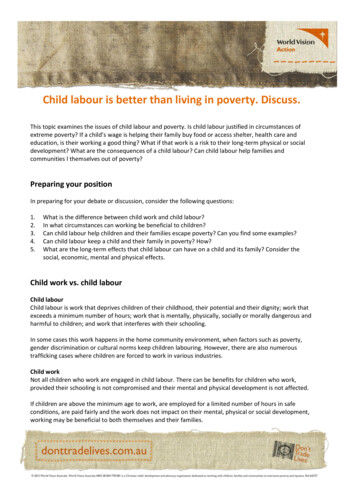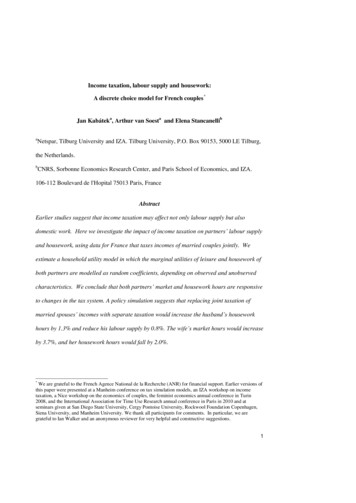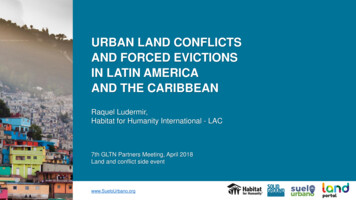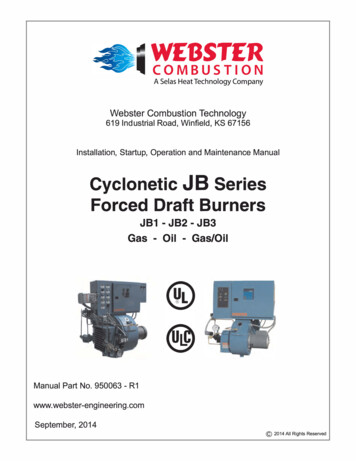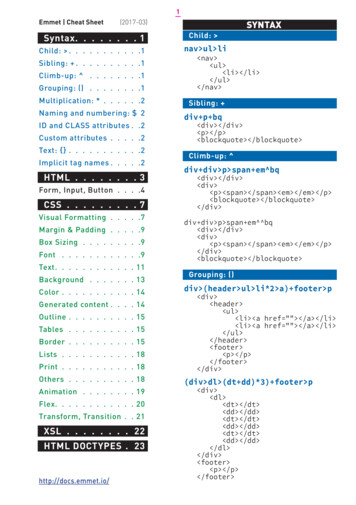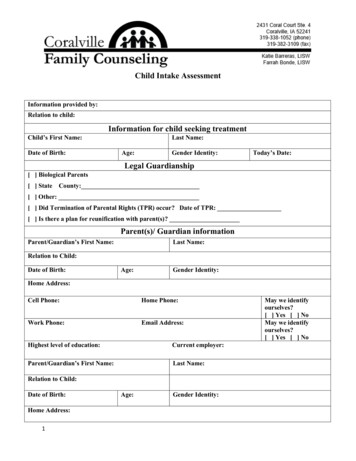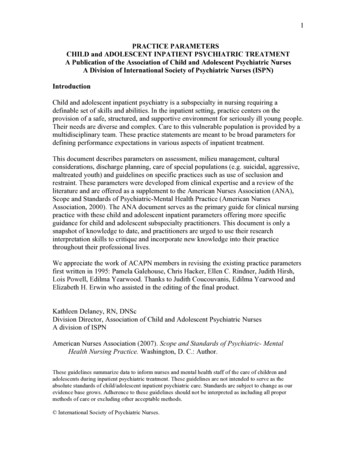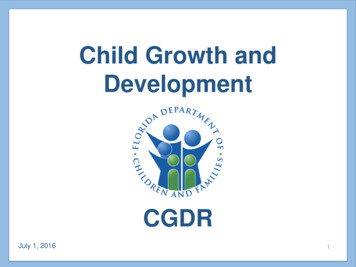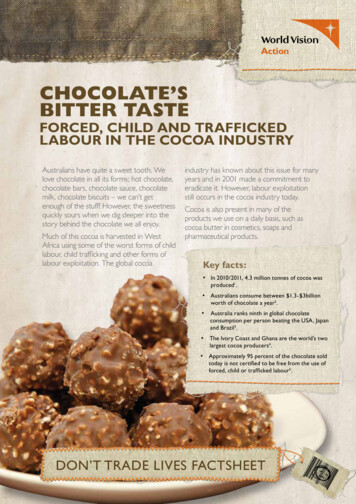
Transcription
Chocolate’sbitter tasteForced, child and traffickedlabour in the cocoa industryAustralians have quite a sweet tooth. Welove chocolate in all its forms; hot chocolate,chocolate bars, chocolate sauce, chocolatemilk, chocolate biscuits – we can’t getenough of the stuff! However, the sweetnessquickly sours when we dig deeper into thestory behind the chocolate we all enjoy.Much of this cocoa is harvested in WestAfrica using some of the worst forms of childlabour, child trafficking and other forms oflabour exploitation. The global cocoaindustry has known about this issue for manyyears and in 2001 made a commitment toeradicate it. However, labour exploitationstill occurs in the cocoa industry today.Cocoa is also present in many of theproducts we use on a daily basis, such ascocoa butter in cosmetics, soaps andpharmaceutical products.Key facts: In 2010/2011, 4.3 million tonnes of cocoa wasproduced1. Australians consume between 1.3- 3billionworth of chocolate a year2 . Australia ranks ninth in global chocolateconsumption per person beating the USA, Japanand Brazil3. The Ivory Coast and Ghana are the world’s twolargest cocoa producers4. Approximately 95 percent of the chocolate soldtoday is not certified to be free from the use offorced, child or trafficked labour5.DON’T TRADE LIVES FACTSHEET
THE ISSUEThe majority of cocoa farmers in West Africa work onsmall farms of no more than 10 hectares6. It is estimatedthere are between 1.5-2 million small cocoa farms acrossGhana and the Ivory Coast7. Many children and adultsmust work to harvest cocoa for global consumption.Often families live in poverty and children must work tohelp support their family. Typically adult farmers are paidpoorly for the cocoa they harvest, further compoundingthe issue. In other cases, children are trafficked and forcedto harvest cocoa.Children as young as six years old work on cocoa farmsunder extremely hazardous conditions8. Carrying heavyloads, using machetes to clear land and inhaling harmfulpesticides are all in a day’s work. Pesticides are commonlyused in cocoa growing regions to control bugs and virusesthat harm the cocoa plant. In West Africa up to 97percent of farmers use pesticides9. Some of these havebeen found to cause headaches, nausea, diarrhoea, liverand kidney complications and even cancer10.Labouring in extreme heat is also common in WestAfrican countries, where midday temperatures canaverage 30-35 degrees throughout the year and thetropical climate means high humidity and a torrentialwet season.Farmer povertySmallholder farmers typically live in poverty. Prices paidto farmers by cocoa buyers are often incredibly low.Hampered by limited bargaining power with cocoa buyers,farmers must accept whatever price they are offered atthe farm gate11. Low cocoa prices, combined with poorproductivity and a vulnerability to price downturns involatile commodity markets, often mean farmers struggleto make enough income to cover production costs.Making matters worse, farmers who do not own theirland must give high proportions of their profits to the landowner, meaning little is left to pay for basic necessitieslike food, shelter and healthcare12 . These factors help tocreate the conditions for labour exploitation and feed thedemand for child labour.What is child labour?Child labour is any kind of work that deprivesa child of their childhood, their potential anddignity, and that is harmful to their physical andmental development. It may include work that ismentally, physically, socially or morally dangerousand harmful to children; that interferes with theirschooling by depriving them of the opportunityto attend school; causes them to leave schoolprematurely or requires them to attempt tocombine school attendance with excessively longand heavy work.
What is trafficking?Human trafficking is putting or keeping someonein an exploitative situation for profit. They arenot free and they are exploited for profit overand over again. It is a serious crime and victimsof trafficking can be men, women and children.Child labourChild traffickingIn developing countries around the world it may be seenas normal for children to help their parents on the farmor in the home, just like children in Australia doing choresafter school or on weekends. However, as a result ofextreme poverty, children often have to work long andphysically demanding days harvesting cocoa to supporttheir families, at the expense of their education andlong-term development. Children may also be exposedto dangerous chemicals and equipment, or work in anenvironment that is damaging to their health. This workcan be detrimental to both their physical and mentaldevelopment.Many children from neighbouring countries are traffickedinto cocoa growing areas and forced to harvest the crop13.Many people profit from this, including brokers who mayarrange for the children to leave their home communities,with promises of an education or better workingopportunities; farm and business owners who profit fromthe cheap labour; international companies who profit fromcheap cocoa in their products and customers around theworld who buy them. Children are forced to work long daysin dangerous conditions for little or no pay. There are alsoreports of children working 80-100 hours a week – morethan double the standard Australian work week – whilebattling poverty, malnutrition and backbreaking work14.
where has your cocoa been?Cocoa farms:Cocoa farmers grow cocoa.Forced, child and traffickedlabour is commonly reportedto be used at this stage ofthe process.Cocoa buyers:Dealers or “middlemen” buycocoa from farmers for a lowprice and sell to processorsand exporters.Exporters:Buy cocoa beans from a network oflocal buyers and sell to processors.Processors:Turn the raw product intodifferent cocoa products – such ascocoa butter, cocoa powder andrefined chocolate – which is thensold on to different companies.Manufacturers:Manufacture and package cocoa products andsend finished product to distributors.Retailers:Sell cocoa products to the public.The cocoa supply chain can differ from company to company. In some cases companies have oversightover the whole process. Other companies outsource these different stages to external partners.
What isbeing done?In 2001, the global cocoa industryacknowledged the use of forced and childlabour and made a commitment to eliminatethe practice. While some companieshave made steps towards addressing theissue, labour exploitation still exists in theindustry and companies are a long way fromeliminating the practice.The fair trade movement“Fair trade” is a market-based approach to tradeand economic development that aims to giveproducers (especially in developing countries) a fairwage, improve their trading capacity and promotesustainability.This system has been increasingly adopted in thecocoa industry to overcome its negative social andenvironmental impacts. Ethical certification schemes suchas Fairtrade International, Rainforest Alliance and UTZCertified help ensure a better deal for farmers and betterconditions for workers through minimum labour, pricingand production standards. When a company sourcesfrom certified farms and maintains the appropriateenvironmental, social and economic standards, it maydisplay the ethical certification logo on the package of thecocoa product.Global non-government organisations (NGOs) have alsoimplemented numerous projects to help prevent the useof forced, child or trafficked labour in the cocoa industry,including supporting farming communities to work withthe ethical certification schemes.As a result of consumer demand, there is an increasingpresence of ethically certified goods in Australia.However, this is still limited to only a handful of chocolatebars from leading chocolate companies which are madefrom ethical cocoa. Around 95 percent of global cocoasupplies still remain uncertified against the use of forced,child and trafficked labour15.The global chocolate industryA number of initiatives have been established by thecocoa industry to improve conditions in cocoa harvestingcommunities and to help eradicate the worst forms ofchild labour. Australia’s leading chocolate companiesNestle, Cadbury, Mars, Ferrero and Lindt & Sprüngli haveall started to implement various schemes16. For somecompanies this includes commitments to using certifiedOther cocoa productsBig chocolate companies are the largest users of cocoaand have been the focus of most calls to eradicateforced and child labour in the industry, but they arenot the only ones with a responsibility to addressthis problem. Other companies using cocoa in theirproducts must also make firm commitments to tracingand transparently reporting on their supply chains andensuring the cocoa they use is not tainted by forced andchild labour. This includes companies who use cocoabutter in products such as cosmetics, lotionsand shampoos.Some have responded by introducing products containingethically certified cocoa or cocoa butter and investing inprojects aimed at assisting cocoa producing communitiesto obtain ethical certification. However, many companieshave not and continue to use cocoa which may have beenproduced using forced or child labour.ethical cocoa from independent certification schemes17.However, others have stated that they will work toensure they source ethical cocoa, without the use ofethical certification schemes18 19 20. This is an acceptablesolution, only if they can prove – through independentverification – that their own schemes are meeting thosestandards of ethical certification schemes.Many companies also fund community developmentprojects and farmer education on crop sustainabilityand support industry-wide projects to improve thetraceability and monitoring of cocoa harvests. Whilethese are worthy initiatives, there remains a lack oftransparency over the efficiency of these schemes toassist the most vulnerable communities and actuallyeradicate the issue of forced, child and trafficked labour.In spite of these efforts, the majority of chocolatecompanies – including the big brand names – are nottransparently reporting where they source their cocoa.This means the cocoa used in their products may havebeen harvested using forced, child or trafficked labour.Chocolate companies must fully report on their cocoasourcing and have their supply chain independentlyverified to demonstrate that they are purchasing ethicalcocoa and are treating farmers fairly.Some companies have made commitments to rectify thisand World Vision continues to monitor their progress.For up to date information about the different chocolatecompanies’ progress, see our Chocolate Scorecard atdonttradelives.com.au
What can YOU DO?You can play a critical role in combating forced,child and trafficked labour by using your voiceand purchasing power to demand cocoaproducts are made ethically.Write to the chocolate companiesChocolate companies need consumers to keep buyingtheir products! Get in touch with the companies whomake the chocolate you love and ask them what they aredoing to eradicate forced, child and trafficked labour fromtheir supply chain. Ask them to:Purchase with prideBuy more ethical chocolate products. Use World Vision’sGood Chocolate Guide21 and the Ethical Guide toSupermarket Shopping to help you decide which brandsto buy. Tell others about buying ethical products via FairlyLocal22 . This site lets you find ethical products near youand add products that you find, so everyone in yourneighbourhood can enjoy them. make a timetabled commitment towards 100percent sourcing of ethically certified cocoa that isindependently verified to have been made without theuse of forced, child and trafficked labour; transparently report on their progress in meeting thesetargets (where a timetabled commitment exists); transparently report on their investment in andprogress of initiatives to directly address forced andchild labour; and increase the supply of ethical cocoa.For more information nal Cocoa Organization (2012)Production of Cocoa Beans. Accessed on: 17 July2012. Available from: reements/cat htmlWorld Vision (2012) Our Guilty Pleasure:Exploitative Child Labour in the ChocolateIndustry – 10 Years on From the Harkin-EngelCocoa Protocol. Available from: onsum/consum.htmlWorld Vision (2012) Our Guilty Pleasure:Exploitative Child Labour in the ChocolateIndustry – 10 Years on From the Harkin-EngelCocoa Protocol. Available from: VAReport Our Guilty Pleasure.sflb.ashxTen Campaign Briefing Paper, 19/09/2011 10 Yearsof Unfulfilled Promises to Eliminate the WorstForms of Child Labour in West Africa’s CocoaSector. Available from: ry International (2004) The CocoaIndustry in West Africa: A History of Exploitation.Available from: http://www.antislavery.org/includes/documents/cm docs/2008/c/cocoareport 2004.pdfTen Campaign Briefing Paper, 19/09/2011 10 Yearsof Unfulfilled Promises to Eliminate the WorstForms of Child Labour in West Africa’s CocoaYoung people from the Holy Trinity Anglican Church encouraged members oftheir community to buy more ethical chocolate and sign petitions asking chocolatecompanies to clean up their supply chains.Sector. Available from: http://www.10campaign.com/static/faq.pdf15.World Vision (2011) Our Guilty Pleasure:Exploitative Child Labour in the ChocolateIndustry – 10 Years on From the Harkin-EngelCocoa Protocol. Available from: VAReport Our Guilty Pleasure.sflb.ashx16.International Labour Organization, About ChildLabor. Accessed on 5 July 2012. Available rnational Labour Organizatio
of forced, child or trafficked labour in the cocoa industry, including supporting farming communities to work with the ethical certification schemes. As a result of consumer demand, there is an increasing presence of ethically certified goods in Australia. However, this is still limited to only a handful of chocolate bars from leading chocolate companies which are made from ethical cocoa .
